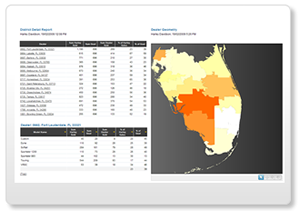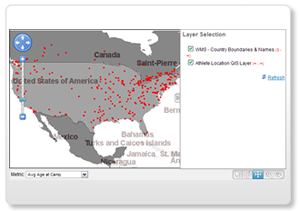The Benefits of Location Intelligence: You?re in real estate, didn?t you know?
In our last Location Intelligence (LI) based blog entry – Defining Location Intelligence – we examined the meaning of LI and explored its potential to be applied to a range of industries and organizations to help contextualize other data, providing better, more actionable information for decision-makers.
As mentioned in the last blog post, most businesses can use LI to improve their bottom line, because around 80 percent of enterprise data is geographically significant is some way. LI also allows you to analyze, visualize and understand the relationships between geographic data and other metrics.
A recent research report – Location Intelligence: What can be Expected as BI embraces Location and Cloud – released in March this year by Saugatuck Technology defines the benefit of LI in the following way:
“Integration of Location (GIS) and standard BI platforms brings LI to greater usefulness by making it available as an option to anyone who is familiar with the more readily-available BI solutions, and without the need to master new concepts or a new user interface. Spatial relationships also greatly enhance many of the details commonly reported by BI systems, providing an added level of analysis that is useful in viewing and assessing trends (and existing data types).”

Sounds good doesn’t it? But what are the tangible benefits of using LI? How does mapping data help uncover hidden truths, obscured opportunities and potential pitfalls?
You’re in real estate, didn’t you know?
I can answer those questions with the utterance of one clichéd phrase: Location, location, location!
The most important facet of any business? Location. More specifically, location in relation to target market, points of distribution, product/service, and a breadth of infrastructure or financial assets.
Location Intelligence: Cars, hamburgers and shopping centers (products)
It doesn’t matter whether you sell cars or hamburgers – you want your product to be easily accessible to your most ideal customers. If you sell luxury cars aimed at the wealthy business executive, constructing a dealership in a suburb where the median household income is $30,000 per annum is a bad idea.
What’s a good position to build a shopping center? Are there enough potential customers (right demographic, psychographic and purchase habits) within a close proximity? Where are these potential customers in comparison to other shopping centers that offer similar products?
Location Intelligence: Sports stadiums (commercial events and services)
When scouting locations for a new sports stadium, amongst a plethora of considerations, you would need the stadium to be well serviced by public transport. Where are the public transport routes located in relation to your target market and the stadium? Can people get there in a timely manner, without exerting undue effort?
Location Intelligence: Government (social services)
But this concept extends far beyond commercial endeavors. What about public and social services? The government of LocationVille is building a new hospital. Where should it be built to best cater for the majority of LocationVille’s population? How big does it need to be to meet the needs of that populace?
At first it seems unlikely, but even low-level government bodies can use LI with great effectiveness. A local council could use LI to plot the distribution of regular borrowers from its libraries. Areas with no borrowers, or low borrowing rates, could be identified and targeted with literacy campaigns. Or, further research could be conducted to establish if additional facilities need to be built.

The Council’s jurisdiction might be plagued by vandalism or graffiti. If so, LI can be applied to track graffiti hotspots. Analyzing the data over time will enable new preventative strategies to be established and implemented with effectiveness.
Location Intelligence: When location is no object (online stores)
What about online stores I hear you enquire. Of what value is LI to them? In this instance; surprise, surprise; location still matters. Knowing where your customers come from allows you to tailor effective communications campaigns. Knowing their location might also assist you in choosing which medium or piece of media to utilize to get your message across.

You’ll also need to know where your customers are in relation to your distribution and supply channels – if you can’t meet demand or deliver the physical product to the customer once the online transaction is complete, you may as well take down your website now.
Location Intelligence: Usefulness by business function
Sales and marketing
LI can benefit sales and marketing initiatives by identifying:
- Customer clustering
- Revenues / sales per country, state, region
- Postal addresses of target customers (helping to develop targeted marketing campaigns by combing addresses with other relevant information such as demographic and transactional data)
- Marketplace gaps, opportunities, threats and level of penetration (by adding in an element of time, it is also possible to track and predict growth)

Planning and construction
LI can benefit planning and construction projects, helping to assess:
- Site selection (identifying the geographic spread of your most profitable customers and how this has changed over time, etc)
- Geographic impacts and factors for current and future developments
Operational and supply chain processes
LI can benefit operational and supply chain processes by:
- Optimizing transit routes (determining the fastest transportation routes and enhancing on-the-move communications by mapping cell phone towers)

- Enabling effective forecasting (matching store locations with the size of surrounding populations can be used as a guide to determine potential profitability)
- Optimizing warehousing processes and stock flows based on the consumption rates of particular products by locality
Can you think of some more applications for LI? Of course you can. This brief exploratory list is a mere scratch on an expansive surface.
Still hungry for examples? Check out our other LI based blog, Defining Location Intelligence.
Location Intelligence: The glue that binds data together
LI allows organizations of all types to realize relationships and opportunities otherwise hidden in their data by enabling enhanced and multi-dimensional analysis. The impact on marketing and distribution is particularly strong.
LI can be used across a breadth of industries – retail, government, telecommunications, financial services, logistics – you name it.
LI is the glue that binds other data assets together.